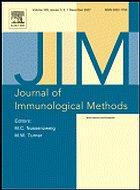|
Literature / Source Database:
Journal of Immunological Methods
| Title (short) |
J. Immunol. Methods |
| Title (abbrev) |
JIM |
| CODEN |
JIMMBG |
| Languages |
English |
| First year |
1972 |
| Impact factor |
1.858 |
|
|

|
Status
active
Indexing
Abstracts on Hygiene and Communicable Diseases; BIOSIS; Chemical Abstracts; Current Contents/Life Sciences; EMBASE; Elsevier BIOBASE; Informedicus;
MEDLINE®; Pascal et Francis (INST-CNRS); Reference Update; Scopus; Tropical Diseases Bulletin;
Subject

Source type
Journal
Publisher
ISBN ISSN
0022-1759
First volume
1
Last volume
333+
Homepage
| Resources |
|
Availability |
|
|
|
|
|
| Text PDF |
 |
free access |
 |
| Text Html |
 |
for subscriber |
 |
| References |
 |
not available |
 |
| Abstracts |
 |
|
|
| TOC |
 |
|
|
|
|
|
|

Description
The Journal of Immunological Methods is devoted to covering techniques for: (1) Quantitating and detecting antibodies and/or antigens and haptens based on antigen-antibody interactions. (2) Fractionating and purifying immunoglobulins, lymphokines and other molecules of the immune system. (3) Isolating antigens and other substances important in immunological processes. (4) Labelling antigens and antibodies with radioactive and other markers. (5) Localizing antigens and/or antibodies in tissues and cells, in vivo or in vitro. (6) Detecting, enumerating and fractionating immunocompetent cells. (7) Assaying for cellular immunity. (8) Detecting cell-surface antigens by cell-cell interactions. (9) Initiating immunity and unresponsiveness. (10) Transplanting tissues. (11) Studying items closely related to immunity such as complement, reticuloendothelial system and others.
In addition the journal will publish articles on novel methods for analysing the organization, structure and expression of genes for immunologically important molecules such as immunoglobulins, T cell receptors and accessory molecules involved in antigen recognition, processing and presentation. Submitted full length manuscripts should describe new methods of broad applicability to immunology and not simply the application of an established method to a particular substance - although papers describing such applications may be considered for publication as a short Technical Note
The journal also welcomes articles relating to modification by recombinant techniques of molecules of immunological interest; isolation of novel binding proteins by phage display; gene therapy; transfection; and expression.
Immunology Protocols is a section providing detailed, step-by-step descriptions of new and established techniques in immunology. Articles on the molecular biological analysis of immunologically relevant receptor binding sites are also invited.
|